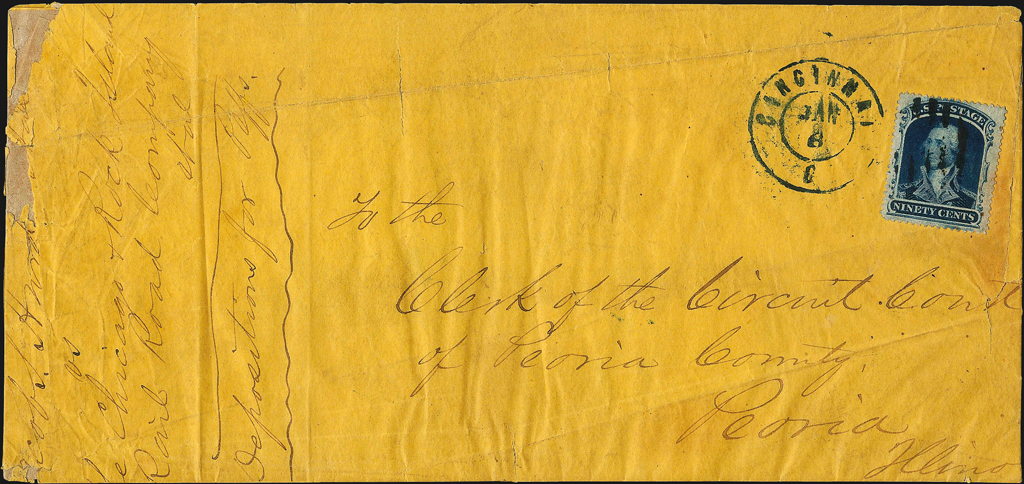Auctions
Filstrup cover hammered down for $37,375

Long known as the Filstrup cover, this unique example of the United States 1860 90¢ issue on a domestic letter went for $37,375 at the Kramer collection sale. Five covers to foreign destinations are known.
On Dec. 15, 2014, Robert A. Siegel Auction Galleries in New York offered the George J. Kramer collection of United States domestic mails from 1776 to 1869. Kramer has won top national awards and major international awards for his exhibits.
The collection offered in this Siegel sale documented the development of postal service in America from independence to the aftermath of the Civil War. Described as a “tour de force in American postal history,” it received philately’s highest honor, the grand prix d’honneur, at the Brasiliana 2013 show.
The nucleus of that eight-frame exhibit, a July 4, 1776, letter addressed to John Hancock, has been donated by Kramer to the National Postal Museum.
Having done all he could with the collection, the catalog explained, Kramer chose to sell the best remaining items and move on.
“As he plans his next exhibit, they are no longer germane and are being returned to the market,” auctioneer Scott Trepel wrote.
The front cover of the auction catalog showed a pair of stampless covers, each endorsed by the signatures of George and Martha Washington, respectively, indicating that the letters were entitled to free postage.
George Washington free franks, while highly sought-after, are not rare. Martha’s are: She was granted free-frank privilege only in 1800, after her husband’s death, and used it for just two years, until her death in 1802. Only four of her franks are known to survive.
The cover with George’s frank, used after he left office, sold for $12,650, including the 15 percent buyer’s premium Siegel adds to all lots. The cover franked “Free M. Washington” sold for $37,375.
More from Linns.com
- Kramer collection, revenues, classic stamps and more in Dec. 15-19 auctions from Siegel
- Auction Roundup: Worldwide rarities change hands at record prices in end-of-the-year sales
- George Kramer wins Grand Prix d'Honneur at Brasiliana show
For a short period before the Post Office Department issued official government postage stamps in 1847, local postmasters produced their own adhesives for the prepayment of postage.
Among the most popular of these postmasters’ provisionals are the series known as the St. Louis Bears, three stamps in denominations of 5¢, 10¢ and 20¢ that get their nickname from the Missouri coat of arms shown in the design, which is supported by a pair of standing bears.
The stamps were printed in black between 1845 and 1847, first on greenish paper, then on gray lilac paper and finally on pelure paper.
The cover in the Siegel sale bears a combination of St. Louis 20¢ black on gray lilac (Scott 11X6) and 10¢ black on greenish (11X2). The stamps are canceled with a line in pen and tied to the folded letter by a bold red “St. Louis, Mo. Apr. 22” circular datestamp. The letter was sent to Philadelphia in 1846, at the prevailing 30¢ rate.
Said to be one of just two surviving covers to combine St. Louis Bear stamps printed on two different papers, it sold for $126,500.
Another highlight of the Kramer collection sale was an 1861 cover with a solo use of the 90¢ Washington stamp of 1860 (Scott 39), sent from Cincinnati to Peoria, Ill.
Docketing on the envelope, known as the “Filstrup cover” in honor of one of its previous owners, shows it held court papers. Its contents would have weighed 15 ounces, requiring franking of 30 times the basic 3¢-per-half-ounce rate.
The 90¢ stamp of 1860 was issued primarily for use on foreign mail (five other covers to foreign destinations are known) and this is its only known use on a domestic letter. The issue was demonetized and withdrawn later in 1861 upon the outbreak of the Civil War. Siegel hammered the Filstrup cover down for $37,375.
More from Linns.com:
No speedy delivery for letter to PMG Brennan
An Open Letter to Postmaster General Megan Brennan
Possible 20¢ Apgar imperf surfaces on 2002 cover in Fla.
PMG Brennan to use technology to revitalize U.S. Postal Service
Upright Jenny Invert pane, imperf stamps from press sheets to be listed by Scott
Keep up with all of Linns.com's news and insights by signing up for our free eNewsletters, liking us on Facebook, and following us on Twitter.
MORE RELATED ARTICLES
Headlines
-
US Stamps
Oct 7, 2024, 3 PMMcMurtrie dismissed as APS education director following Sept. 21 arrest
-
US Stamps
Oct 7, 2024, 12 PMVasiliauskas named president of Mystic Stamp Co.
-
US Stamps
Oct 6, 2024, 5 PMApgar souvenir card available
-
US Stamps
Oct 6, 2024, 4 PMFirst Continental Congress and U.N. stamps receive Scott catalog numbers





